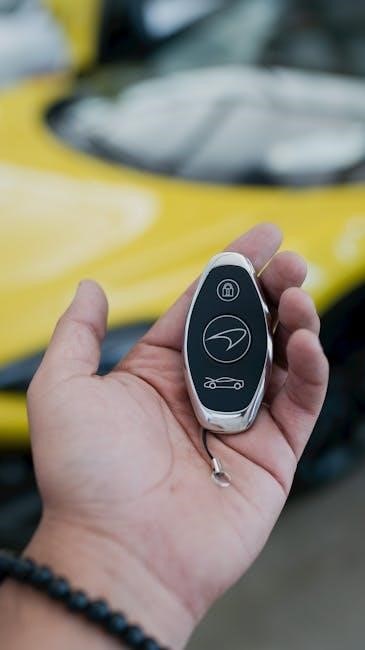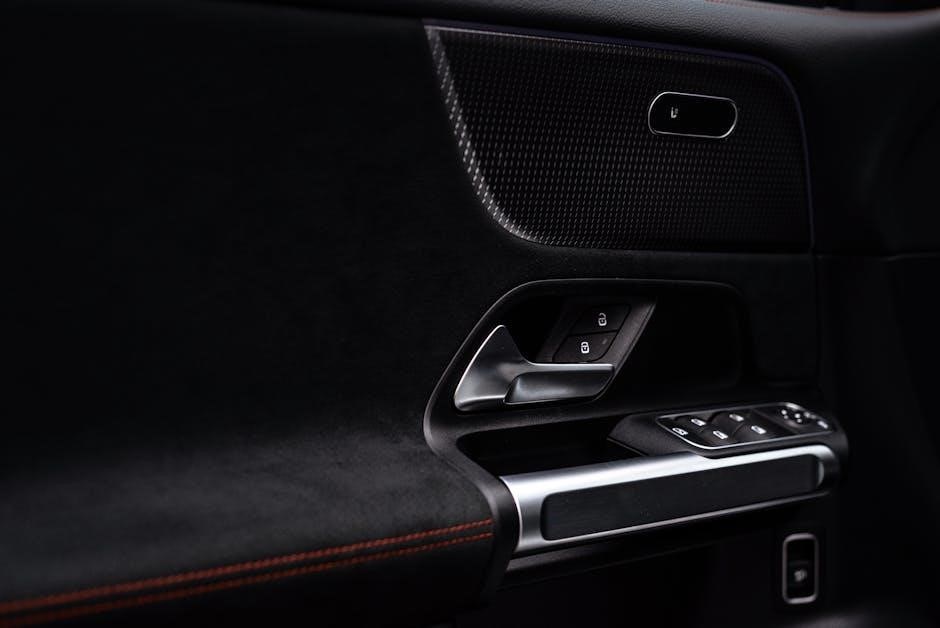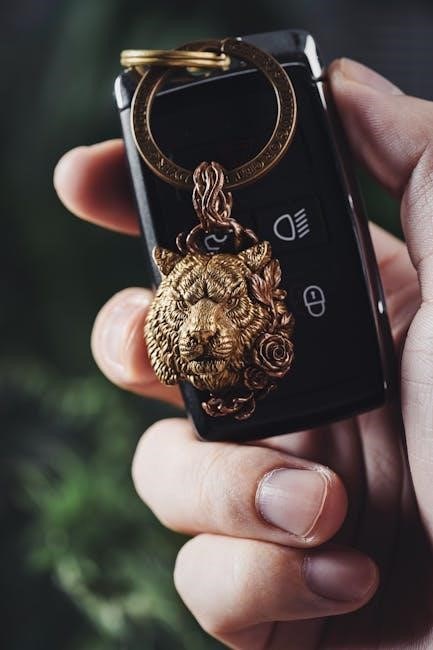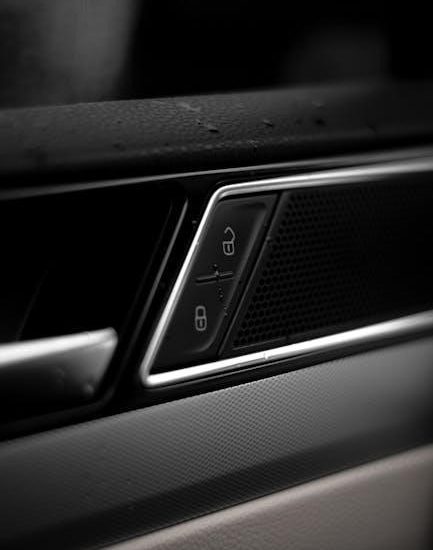When a manual car key fails to unlock the car door, it can lead to frustration and inconvenience. This issue often stems from a combination of factors, including worn-out keys, damaged or corroded lock mechanisms, misaligned doors, frozen locks, or electrical problems in power locking systems. Understanding the root cause is essential for effective troubleshooting and resolution, ensuring you can regain access to your vehicle efficiently.
Common Causes of the Problem
The manual key failing to unlock the car door can result from a worn-out key, a damaged or corroded lock mechanism, misaligned door and lock, frozen or jammed locks, or electrical issues in power locks.
2.1. Worn-Out Key
A worn-out key is a common reason why a manual key may fail to unlock the car door. Over time, the teeth of the key can become dulled or misshapen, reducing its ability to properly engage with the lock pins inside the cylinder. This wear can occur naturally due to frequent use or from improper handling of the key. If the key is too worn, it may turn in the lock but fail to align correctly with the pins, preventing the lock from disengaging. Using a worn key repeatedly can also damage the lock mechanism, exacerbating the issue. Regular key maintenance or replacing a worn key can often resolve this problem before it becomes severe. Additionally, keeping a spare key on hand can provide a reliable backup if the primary key becomes unusable.
2.2. Damaged or Corroded Lock Mechanism

A damaged or corroded lock mechanism can prevent a manual key from unlocking the car door. Corrosion often occurs due to exposure to moisture, dirt, or extreme weather conditions, which can degrade the internal components of the lock. If the lock’s pins, springs, or cylinder become corroded or rusted, the key may not align properly, leading to malfunction. Physical damage to the lock from accidents or forced entry attempts can also disrupt its functionality. In such cases, lubricating the lock or replacing corroded parts may be necessary to restore proper function. If the damage is severe, professional intervention by a locksmith or mechanic is typically required to repair or replace the lock mechanism entirely. Regular maintenance, such as cleaning and lubricating the lock, can help prevent corrosion and extend the lifespan of the locking system. Additionally, using a graphite-based lubricant is recommended as it does not attract dust and dirt like WD-40, which can exacerbate the issue over time. Addressing the problem early on can prevent further complications and ensure the lock operates smoothly. If the lock mechanism is beyond repair, replacement is the most reliable solution to regain secure and consistent access to the vehicle. This ensures both convenience and safety for the driver and passengers. Moreover, recognizing the signs of a damaged or corroded lock, such as difficulty turning the key or a loose keyhole, allows for timely intervention before the issue escalates. By addressing these problems promptly, car owners can avoid potential breakdowns and maintain their vehicle’s overall security and functionality. Regular inspections and maintenance are crucial in preventing such issues and ensuring the lock mechanism remains in optimal condition. If the problem persists despite these efforts, seeking professional assistance is advisable to avoid further damage and ensure effective resolution. This approach not only saves time and money but also enhances the vehicle’s reliability and performance. In conclusion, a damaged or corroded lock mechanism is a common yet solvable issue that requires attention to detail and appropriate action to restore the car door’s locking functionality.
2.3. Misaligned Door and Lock

A misaligned door and lock can prevent a manual key from unlocking the car door. This issue often arises after a vehicle accident, repeated slamming of the door, or natural wear and tear. If the door’s alignment with the lock mechanism is off, the key may not fit or turn properly, even if the lock itself is functional. Signs of misalignment include difficulty inserting the key or resistance when turning it. To resolve this, the door and lock may need to be realigned or adjusted by a professional locksmith or mechanic. Lubricating the lock can sometimes provide temporary relief, but proper alignment is essential for long-term functionality. If left unaddressed, the misalignment can lead to further damage, making the problem more challenging and costly to repair. Regular inspections of the door and lock alignment can help prevent this issue and ensure smooth operation. Additionally, avoiding force when closing the door and addressing minor misalignments promptly can help maintain proper functionality. In severe cases, professional intervention may be necessary to realign or replace components, ensuring the door locks and unlocks seamlessly. Proper alignment is crucial for the lock mechanism to function as intended, allowing the key to operate effectively and securely. By addressing misalignment issues early, car owners can prevent further complications and maintain the integrity of their vehicle’s locking system. Regular maintenance and careful handling of the door can go a long way in preserving the alignment and functionality of the lock mechanism. Misalignment is a common issue that can be resolved with the right approach, ensuring the car door operates smoothly and securely.
2.4. Frozen or Jammed Locks

Frozen or jammed locks are a common issue, especially in cold weather. Moisture inside the lock can freeze, causing the mechanism to seize. This prevents the key from turning, even if it’s in good condition. Jams can also occur due to dirt, debris, or corrosion buildup. To address this, apply a penetrating oil or graphite-based lubricant to thaw and clear the lock. Avoid using force, as it may damage the mechanism. If the lock remains jammed, professional assistance may be required to repair or replace it, ensuring smooth operation. Regular lubrication can help prevent future issues. Proper maintenance is key to avoiding frozen or jammed locks. Always clean the lock after exposure to harsh conditions and consider using a lock de-icer during winter months. This proactive approach can save time and money by preventing lock malfunctions. Additionally, storing keys properly and avoiding harsh chemicals can contribute to maintaining lock health. If the problem persists, consulting a locksmith is advisable to restore functionality. Frozen or jammed locks can be resolved with the right techniques, ensuring the car door unlocks smoothly. Regular care and attention can prevent such issues, keeping your vehicle’s locks in optimal condition. By addressing frozen or jammed locks promptly, you can avoid further complications and maintain the security of your car. Proper maintenance is essential for preserving the functionality and longevity of your car’s locking system. Taking preventive measures can help you avoid the inconvenience of a frozen or jammed lock, ensuring uninterrupted access to your vehicle. Regular checks and timely interventions are vital for maintaining the health of your car’s locks, especially in extreme weather conditions. Always prioritize lock maintenance to prevent unexpected issues and ensure your car remains secure and accessible.
2.5. Electrical Issues in Power Locks
Electrical issues in power locks can prevent a manual key from unlocking the car door, especially in vehicles with advanced locking systems. Faulty actuators, wiring problems, or a blown fuse may disrupt communication between the lock and the key. A dead car battery can also disable power locks, making manual unlocking difficult. Additionally, a failed lock control module or key fob malfunction may contribute to the problem. Checking the vehicle’s electrical system, including fuses and wiring, is essential. If electrical components are faulty, professional repair or replacement may be necessary to restore functionality. Regular maintenance of the electrical system can help avoid such issues. Always ensure the vehicle’s battery is in good condition to prevent unexpected lock malfunctions. Addressing electrical problems promptly can restore proper locking mechanisms, ensuring the manual key works effectively. Proper care of the electrical components is crucial for maintaining reliable car door operation. By identifying and resolving electrical issues, you can avoid the inconvenience of a car door that won’t unlock. Regular inspections and timely repairs can prevent electrical-related lock problems, keeping your vehicle secure and accessible. Electrical issues in power locks can often be resolved with basic troubleshooting, saving time and money. If the problem persists, consulting a professional locksmith or mechanic is recommended. Proper care and attention to the electrical system can prevent future issues, ensuring smooth operation of your car’s locks. Always prioritize regular maintenance to avoid electrical-related problems that could leave you stranded. By addressing these issues, you can maintain the reliability of your car’s locking system and ensure uninterrupted access to your vehicle. Electrical issues in power locks can be resolved with the right approach, restoring the functionality of your manual key and car door. Proper care and attention to the electrical system are vital for maintaining the performance of your car’s locks. By staying proactive, you can avoid the frustration of a car door that won’t unlock due to electrical problems. Regular checks and timely interventions can prevent such issues, ensuring your car remains secure and accessible. Always consider the electrical system when troubleshooting a manual key that won’t unlock the car door, as it is a common source of problems. With the right tools and knowledge, many electrical issues can be resolved at home, saving you time and money. If the problem is beyond your expertise, seeking professional help is the best course of action to restore proper function to your car’s locks. Proper care and attention to the electrical system can prevent future issues, ensuring your car’s locks operate smoothly. By addressing electrical problems promptly, you can avoid the inconvenience of a car door that won’t unlock, keeping your vehicle secure and accessible at all times. Electrical issues in power locks are a common challenge but can often be resolved with basic troubleshooting and maintenance. Always prioritize regular inspections and timely repairs to prevent such issues from arising. By doing so, you can maintain the reliability of your car’s locking system and ensure uninterrupted access to your vehicle. Electrical issues in power locks can sometimes be resolved by simply charging the car battery or replacing a blown fuse, making it important to check these basics first. If the problem persists, more in-depth troubleshooting may be necessary. Proper care and attention to the electrical system can help prevent future issues, ensuring your car’s locks remain functional and reliable. Always consider the electrical system when dealing with a manual key that won’t unlock the car door, as it is a common source of problems. With the right tools and knowledge, many electrical issues can be resolved at home, saving you time and money. If the problem is beyond your expertise, seeking professional help is the best course of action to restore proper function to your car’s locks. Proper care and attention to the electrical system can prevent future issues, ensuring your car’s locks operate smoothly. By addressing electrical problems promptly, you can avoid the inconvenience of a car door that won’t unlock, keeping your vehicle secure and accessible at all times. Electrical issues in power locks are a common challenge but can often be resolved with basic troubleshooting and maintenance. Always prioritize regular inspections and timely repairs to prevent such issues from arising. By doing so, you can maintain the reliability of your car’s locking system and ensure uninterrupted access to your vehicle. Electrical issues in power locks can sometimes be resolved by simply charging the car battery or replacing a blown fuse, making it important to check these basics first. If the problem persists, more in-depth troubleshooting may be necessary. Proper care and attention to the electrical system can help prevent future issues, ensuring your car’s locks remain functional and reliable. Always consider the electrical system when dealing with a manual key that won’t unlock the car door, as it is a common source of problems. With the right tools and knowledge, many electrical issues can be resolved at home, saving you time and money. If the problem is beyond your expertise, seeking professional help is the best course of action to restore proper function to your car’s locks. Proper care and attention to the electrical system can prevent future issues, ensuring your car’s locks operate smoothly. By addressing electrical problems promptly, you can avoid the inconvenience of a car door that won’t unlock, keeping your vehicle secure and accessible at all times. Electrical issues in power locks are a common challenge but can often be resolved with basic troubleshooting and maintenance. Always prioritize regular inspections and timely repairs to prevent such issues from arising. By doing so, you can maintain the reliability of your car’s locking system and ensure uninterrupted access to your vehicle. Electrical issues in power locks can sometimes be resolved by simply charging the car battery or replacing a blown fuse, making it important to check these basics first. If the problem persists, more in-depth troubleshooting may be necessary. Proper care and attention to the electrical system can help prevent future issues, ensuring your car’s locks remain functional and reliable. Always consider the electrical system when dealing with a manual key that won’t unlock the car door, as it is a common source of problems. With the right tools and knowledge, many electrical issues can be resolved at home, saving you time and money. If the problem is beyond your expertise, seeking professional help is the best course of action to restore proper function to your car’s locks. Proper care and attention to the electrical system can prevent future issues, ensuring your car’s locks operate smoothly. By addressing electrical problems promptly, you can avoid the inconvenience of a car door that won’t unlock, keeping your vehicle secure and accessible at all times. Electrical issues in power locks are a common challenge but can often be resolved with basic troubleshooting and maintenance. Always prioritize regular inspections and timely repairs to prevent such issues from arising. By doing so, you can maintain the reliability of your car’s locking system and ensure uninterrupted access to your vehicle. Electrical issues in power locks can sometimes be resolved by simply charging the car battery or replacing a blown fuse, making it important to check these basics first. If the problem persists, more in-depth troubleshooting may be necessary. Proper care and attention to the electrical system can help prevent future issues, ensuring your car’s locks remain functional and reliable. Always consider the electrical system when dealing with a manual key that won’t unlock the car door, as it is a common source of problems. With the right tools and knowledge, many electrical issues can be resolved at home, saving you time and money. If the problem is beyond your expertise, seeking professional help is the best course of action to restore proper function to your car’s locks. Proper care and attention to the electrical system can prevent future issues, ensuring your car’s locks operate smoothly. By addressing electrical problems promptly, you can avoid the inconvenience of a car door that won’t unlock, keeping your vehicle secure and accessible at all times. Electrical issues in power locks are a common challenge but can often be resolved with basic troubleshooting and maintenance. Always prioritize regular inspections and timely repairs to prevent such issues from arising. By doing so, you can maintain the reliability of your car’s locking system and ensure uninterrupted access to your vehicle. Electrical issues in power locks can sometimes be resolved by simply charging the car battery or replacing a blown fuse, making it important to check these basics first. If the problem persists, more in-depth troubleshooting may be necessary. Proper care and attention to the electrical system can help prevent future issues, ensuring your car’s locks remain functional and reliable. Always consider the electrical system when dealing with a manual key that won’t unlock the car door, as it is a common source of problems. With the right tools and knowledge, many electrical issues can be resolved at home, saving you time and money. If the problem is beyond your expertise, seeking professional help is the best course of action to restore proper function to your car’s locks. Proper care and attention to the electrical system can prevent future issues, ensuring your car’s locks operate smoothly. By addressing electrical problems promptly, you can avoid the inconvenience of a car door that won’t unlock, keeping your vehicle secure and accessible at all times. Electrical issues in power locks are a common challenge

Quick DIY Fixes to Try
Start with simple solutions like lubricating the lock, using a Slim Jim, or cleaning the key. These quick fixes often resolve the issue without professional help.





